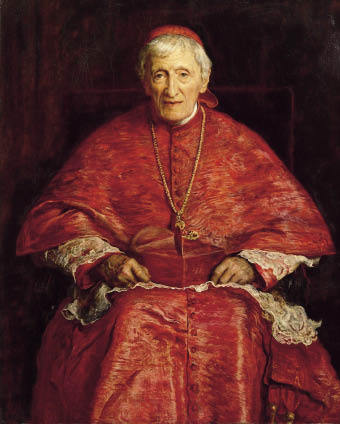John Henry Newman was an electrifying personality who has attracted numerous biographers and commentators. John Cornwell, in his excellent guided tour around this well-ploughed field, recalls the young woman in Oxford in the 1830s who ‘wept with emotion’ at Newman’s very appearance. W. G. Ward recalls the awe which fell upon him and his undergraduate friends if Newman so much as passed them in the street. And figures such as Mark Pattison, James Anthony Froude and Matthew Arnold, none of them followers of the Newman cult in grown-up life, recollected similar feelings in their youth. When the mature George Eliot read Newman’s spiritual autobiography, she said it ‘breathed much life into me’.
What qualities does John Cornwell, himself a Roman Catholic, an excellent writer and former candidate for the priesthood, bring to the task of recreating Newman’s life? There are three qualities which mark this book out for special commendation. First, Cornwell sees that Newman was first and foremost a writer. One of Newman’s fellow priests, after he had become RC, noted that he even prayed with a pen in his hand. Those who did not like Newman — and they included a high proportion of his new co-religionists after he left the C of E — never really came to grips with the fact that he was a writer with a writer’s temperament. His spiritual development, and the crisis of the 19th century, its loss of faith, were matters which Newman addressed through the medium of the written and printed word. His autobiography was sparked by a controversy in a magazine with another author — Charles Kingsley.
Cornwell has a natural feel for all this, and his exposition of the Newman masterpieces is flawless. These books are the Essay on the Development of Christian Doctrine, one of the most original works of theology ever written, the Apologia Pro Vita Sua, and the book he published in old age, An Essay in Aid of the Grammar of Assent, a defence of theism which I, for one, find persuasive.
Cornwell is also excellent at drawing out what is good in Newman’s fiction and poetry, while admitting their very obvious limitations. There is an especially illuminating section in which Newman is compared with Wordsworth.
Secondly, Cornwell is a practised journalist, and he loves gossip and a good story. This book is a page-turner. He investigates the unearthing of Newman’s grave — they found nothing in it! — and all the behind-the-scenes drama of the modern RC church trying to make Newman into a saint, with tremendous panache. He also has the gossip’s instinct for all the ‘good bits’ in Newman’s life. He traces with hilarity, but without malice, the transformation of Ambrose St John, from the golden Oxonian youth who accompanied Newman on his spiritual Road to Rome into a paunchy old priest in Birmingham, forever puffing on cigars and downing large glasses of brandy and orange as he sat with the great man in his rooms at the Oratory in the Hagley Road.
Thirdly, Cornwell, a thoughtful Catholic intellectual of our own day, explains the significance of Newman for today’s church and his influence on the Second Vatican Council. Cornwell even suggests that Newman’s relaxed, and completely chaste, homoeroticism, and his cult of friendship, is an obvious example for some of the poor tormented celibate clergy of today’s world to follow.
But the title explains why this book is so timely. As we all know, the Pope is scheduled to come to England later this year and one of the reasons for his visit is to beatify Newman — to declare him the Blessed John Henry. Cornwell recounts a miracle which is said to provide the justification for this exercise — a 70-year-old deacon in Boston, Massachusetts has been cured of intolerable pains in his back as a result, it is believed, of Cardinal Newman’s intercessions.
This is the moment when non-Roman Catholics politely look at their toes. Does it make sense to speak of Newman as a saint? Very religious he certainly was, but Cornwell paints a picture here of an advanced egomaniac. Much of the second half of Newman’s life was spent in various exercises of self-contemplation, of which the Apologia was only one example. I had not realised until reading Cornwell how long Newman spent sorting through his correspondence. The picture of this old man filing 30-year-old letters and recollecting the moment he stopped talking to this Oxford don or that reminded me of the self-obsessed Tony Benn’s lifework in the basement at Holland Park, keeping all his old tapes and diaries. Newman notoriously quarrelled with Father Faber over the establishment of the London Oratory, and the letters quoted here are feline and acid. Cornwell is also rather devastating — perhaps more devastating than he intended — in his exposition of Newman’s religious thought. Yes, there are those great books. But there are also passages of sheer nonsense, such as the sermon in which Newman says that the Catholic Church holds
it were better for sun and moon to drop from heaven, for the earth to fail, and for all the many millions upon it to die of starvation in extremest agony. . . than that one soul should commit one single venial sin.
In my youth, I was a besotted Newmaniac. I closed Cornwell’s admirable book wondering why. I can see that Newman is a perennially interesting figure, but a saint? Richard Hooker was obviously both a better theologian and a more saintly priest. George Herbert was a better poet and a deeper saint. In his own day, Newman could not match the saintliness of John Keble. None of these have, as far as we know, returned from beyond the grave to give orthopaedic assistance to the gerontic population of Boston, Massachusetts, but their lives nonetheless seem more impressive.






Comments